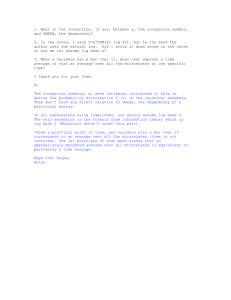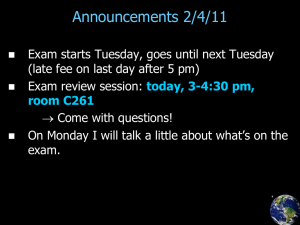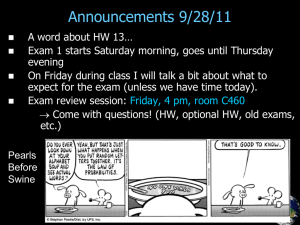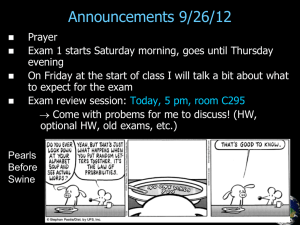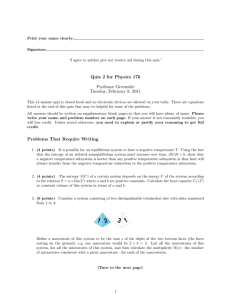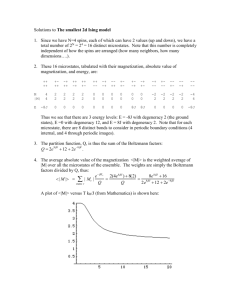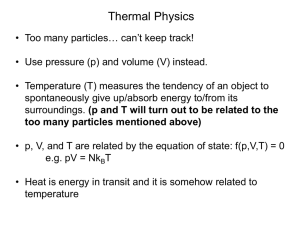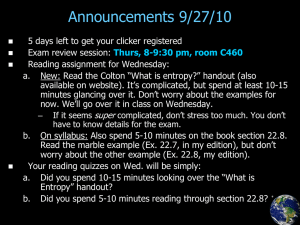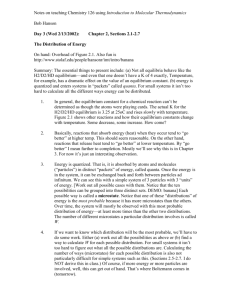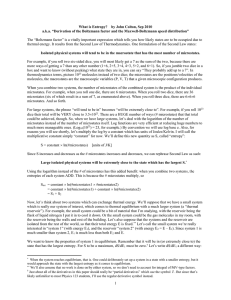lecture 13 - what is entropy?
advertisement
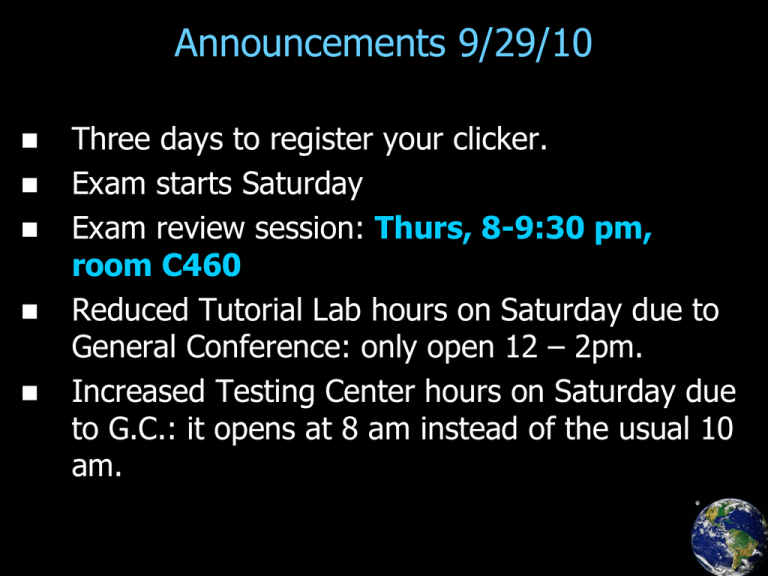
Announcements 9/29/10 Three days to register your clicker. Exam starts Saturday Exam review session: Thurs, 8-9:30 pm, room C460 Reduced Tutorial Lab hours on Saturday due to General Conference: only open 12 – 2pm. Increased Testing Center hours on Saturday due to G.C.: it opens at 8 am instead of the usual 10 am. Thought Question A gas in contact with a thermal reservoir undergoes an isothermal expansion. The gas and the thermal reservoir are isolated from the rest of the universe. Which of the following is true? a. The entropy of both the gas and the reservoir will increase. b. The entropy of both the gas and the reservoir will decrease. c. The entropy of both the gas and the reservoir will not change. d. The entropy of the gas will go up, the entropy of the reservoir will go down, and the total entropy of the system will not change. e. The entropy of the gas will go up, the entropy of the reservoir will go down, and the total entropy of the system will increase. Reading quiz Did you spend at least 10-15 mins looking over Dr Colton’s “What is Entropy?” handout? a. Yes b. No Did you spend at least 5-10 mins reading the book section 22.8? a. Yes b. No Microstates vs Macrostates Reminder a. Left microstate: part of the “royal flush” macrostate b. Right microstate: part of the “garbage” macrostate Dice You roll two dice. What are the microstates? (1,1),(1,2),(1,3),(1,4),(1,5),(1,6),(2,1),(2,2),… How many microstates are there? How does that compare to the number of microstates for rolling one die? How many microstates if we roll 3 dice? What are the macrostates for 2 dice? (sum of numbers) What is the most likely macrostate? MANY Dice You roll 1023 dice with your left hand. How many microstates are there? You roll 1023 dice with your right hand. How many microstates are there? How many microstates are there in the COMBINED system? Isn’t this ridiculous? Solution: Use logarithms S = some constant ln(#microstates) [units of J/K] a. Much more manageable numbers. b. Combining two systems: Stot = C ln(#microstates1 #microstates2) = C ln(#microstates1) + C ln(#microstates2) = S1 + S2 c. System in macrostate with most microstates system in macrostate with largest S System and Reservoir System: E1 Reservoir: E2 Etot = E1 + E2 (const. volume so no work) 0 = dE1 + dE2 Want to maximize S: take dS/dE1, set = 0 dS d S1 S2 dE1 dE1 dS1 dS 2 dE1 dE1 dS1 dS 2 dE1 dE2 dS1 dS 2 dE1 dE2 Temperature dS/dE is the same for two systems in thermal contact! Temperature is the same for two systems in thermal contact! a. dS/dE has units of 1/K… Compare to dS 1 dE T dQ dS T We are assuming no work, so dE=dQ (First Law) This “works” if the constant is chosen properly: S = kB ln(#microstates) Small system with 2 possible energies: E1A vs E1B (1 microstate each) Probability of system 1 being in state A vs state B? P1A ~ (#microstates of system 1 having energy E1A) (#microstates of system 2 having energy E2A = E – E1A) Let #microstates of E1A = 1 for now. Same thing for state 1B… P1A # microstates of 2 for case A P1B # microstates of 2 for case B P1A # microstates of 2 for case A e S2 A S P1B # microstates of 2 for case B e 2 B kB kB Math… P1A # microstates of 2 for case A e S2 A S P1B # microstates of 2 for case B e 2 B kB kB S 2 A S 2 ( E E1 A ) “of”, not “times” dS 2 S2 ( E ) E1 A dE E1 A S2 ( E ) T (same with S 2 B ) E1 A / k BT P1A e Result: E /k T P1B e 1B B The Boltzmann Factor P~e E / kBT The Boltzmann Factor Prob ~ BF; Prob = BF/(sum of all BFs) Worked Problem: Suppose an atom has only two available energy levels, which are separated by 210-23 J. If the temperature is 1.5 K, what is the probability the atom is in the lower state? Maxwell-Boltzmann Velocity Distribution E = ½mv2 What’s probability of having speed 5 vs speed 10? P1A e E1 A / kBT E /k T P1B e 1B B v 2 1 mv 2 / k BT e 2 1 mv A2 / k BT 2 2 e P1 A v A 1 P1B mvB 2 / k BT 2 2 vB e Multiplicities (Number of states with speed v) ~ v2 Maxwell-Boltzmann Velocity Distribution The result: P(speed v) v 2 1 mv 2 / k BT e 2 1 2 mv / k BT 2 2 v e 1 2 mv / k BT 2 2 v e dv 0 Exactly the equation given for the velocity distribution in your textbook! (after you do the integral in the denominator with, e.g. Mathematica)
